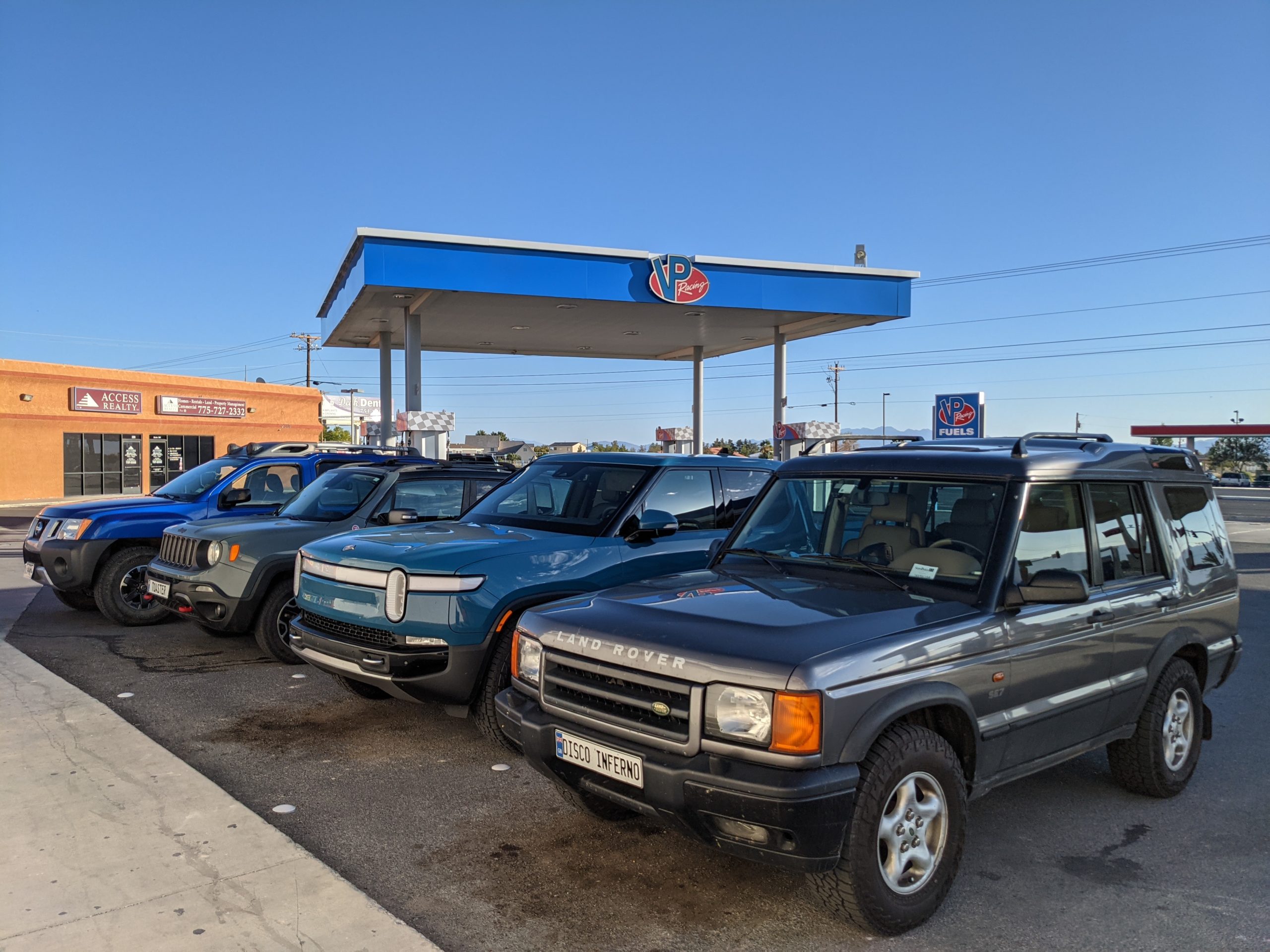
Last stop in Pahrump before heading into the park by Deadman’s Pass.
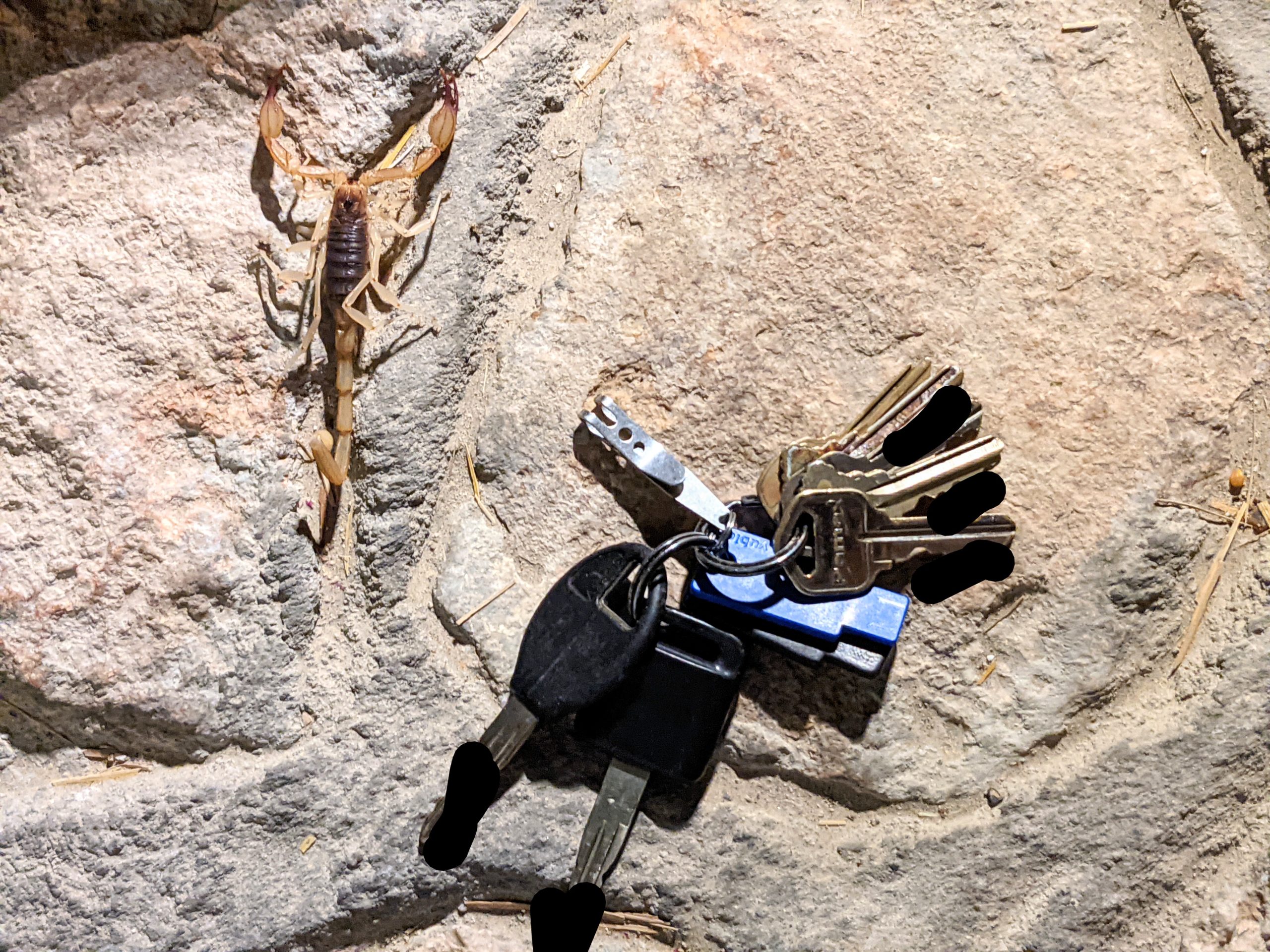
Keyring for scale because otherwise no one would believe me about my five inch scorpion.
Today was a long run from Flagstaff to Death Valley by way of charging and refueling stops in Kingman, Las Vegas, and Pahrump.
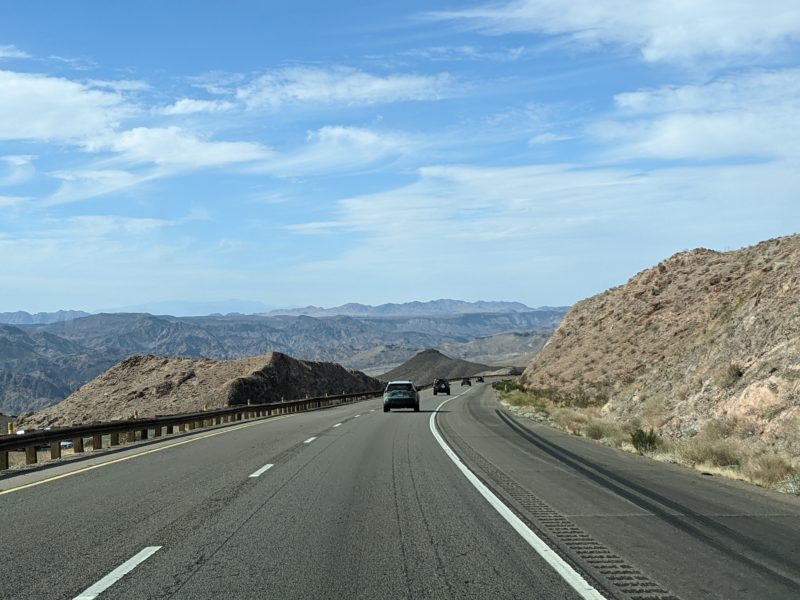
We’re shooting to keep a healthy buffer on the batteries given we’re still learning how heavy mileage days affect range and that the punishment for running out of battery-gas is “someone has to tow you to a charger.” And as with its petrol-based buddies, the Rivian’s estimated range is severely affected by mountain climbing. But unlike we three, descending from the top of a pass can actually restore a bit of additional range, which is pretty sweet. And today’s total altitude loss was about 7000 feet, as Furnace Creek is below sea level.
Ultimately, managing charge level and expected range in an EV is a little more of a dance than I had realized, particularly since several of the chargers in the Death Valley vicinity have been reported by other drivers as broken. But each charging stop has been fairly short and given us enough time to get gas, run errands, eat, use the bathroom, or raid the snack boxes in our trunks.
By the time we rolled out of Pahrump, it was already getting a little later than originally hoped, but that just meant a colorful golden-hour approach toward our final mountain range before the park, so I thought it was fantastic.
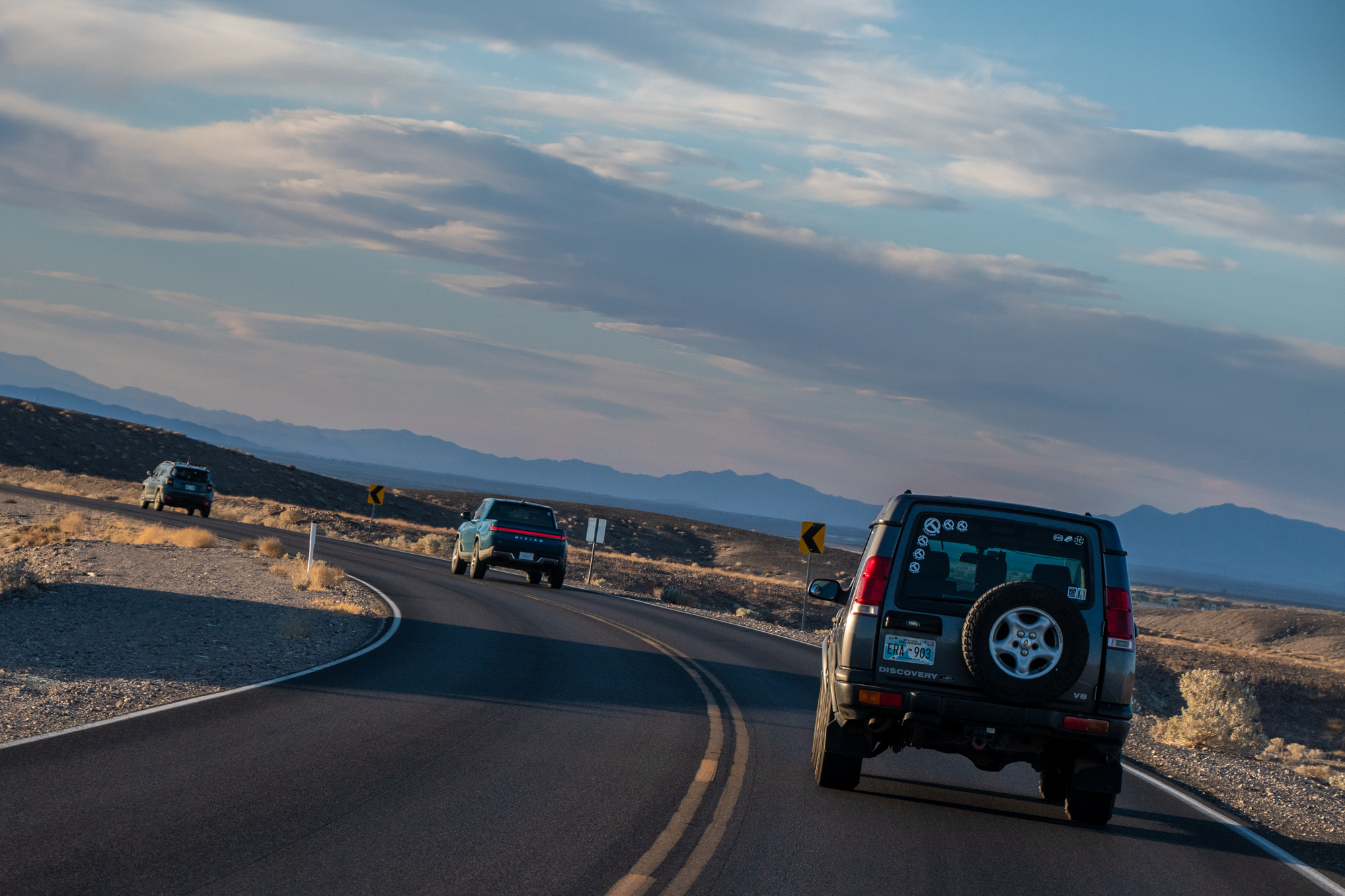
Given the time, we figured we had enough daylight for something more fun than the main park highway, but not one of the big trails. So we set out for Deadman Pass, rewinding our steps from that trip in 2017. That was our exit from the park last time. It’s a simple unpaved road with some bounces and sandy swerving, but nothing too difficult. So it was a great first overland run of the trip, and welcome after so many miles on the interstate.
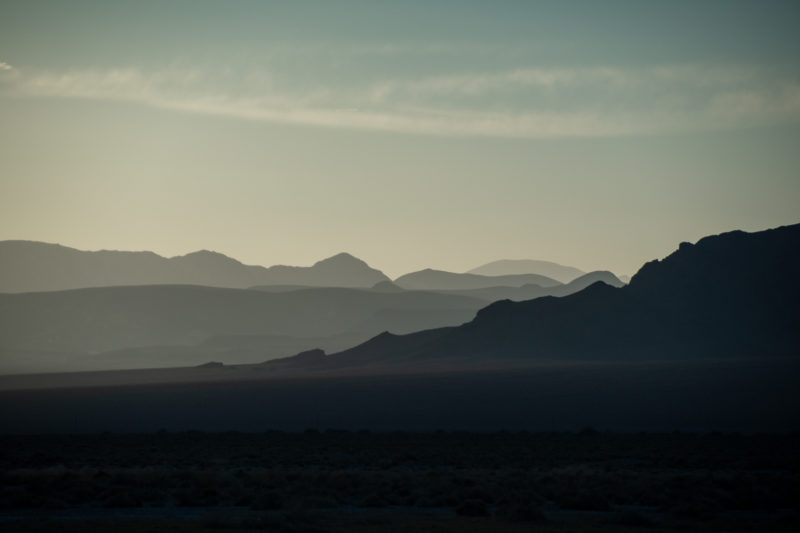
I hate my music. There’s a sound effect in it that sounds like a failing u-joint.
Evan.
Unfortunately, it gets dark very quickly out here. As the sun set, the almost-full moon rose. Thankfully this is an easy one to run at night, so we were able to enjoy the view.
Oh no! The receipt paper I keep wedged between my radio and my air conditioning to keep it from squeaking seems to be missing, so everything’s squeaking and it’s terrible. I think one of you stole it.
Taylor.
I will say, between the R1T’s fancy independent air suspension with “off-road mode,” brand new chonky tires, electric motors on all four wheels, and a driver ready to jump in and have some fun — the Rivian was entirely composed with an ever cheerful expression on its anthropomorphic light-face. While Evan and I bounced across the washes, Andrew seemed to be able to run it all without too much drama, as narrated by George who could see all three of us.
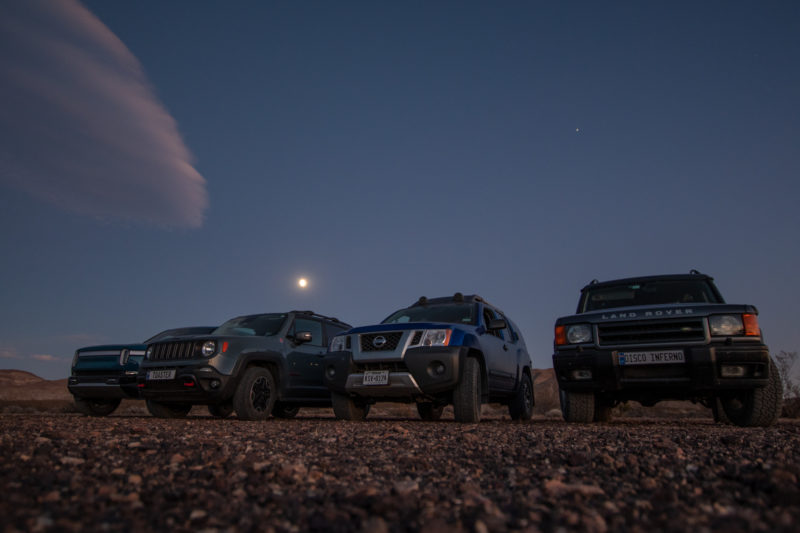
It was really fun to return to Deadman’s Pass as a group. Try as I might, I can find nothing of the history of this pass other than our own — though no Jeeps perished in the making of today’s adventures. Whatever its origin, the pass tracks a wide gap between two mountains at the edge of the vast expanse that is Death Valley. Much moreso than a park highway, it gets you in the mood for truly being in the dried up middle of nowhere.
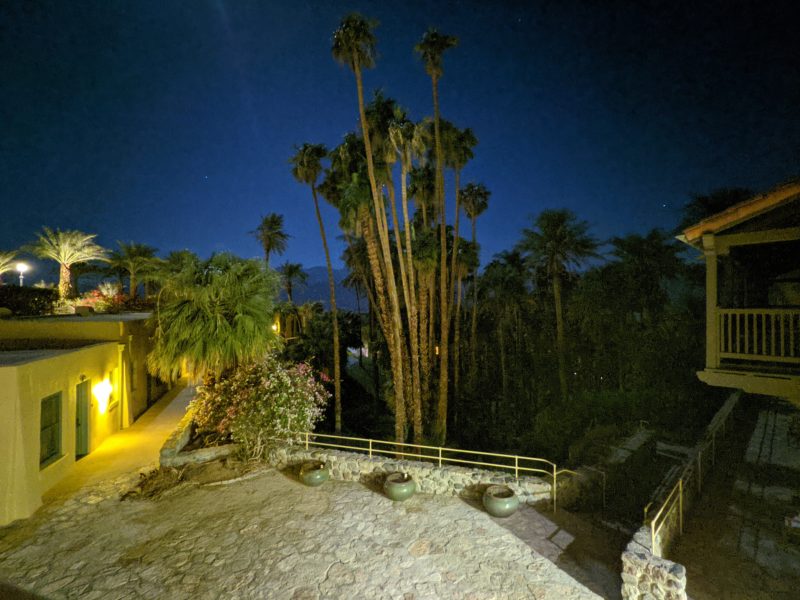
We also decided to put in for an upgrade in our accommodations since we’ll be here two days. The Inn at Furnace Creek is the resort side of the park accommodations, a swanky step up from The Ranch where we stayed last time. It’s actually listed on the Historic Hotels of America registry. The inn originally opened in 1927 to serve visitors coming in on a borax mine magnate’s railroad as he attempted to increase revenue by building a tourism business in Death Valley. It has been operating almost full-time since. I love the shared balcony arrangement.
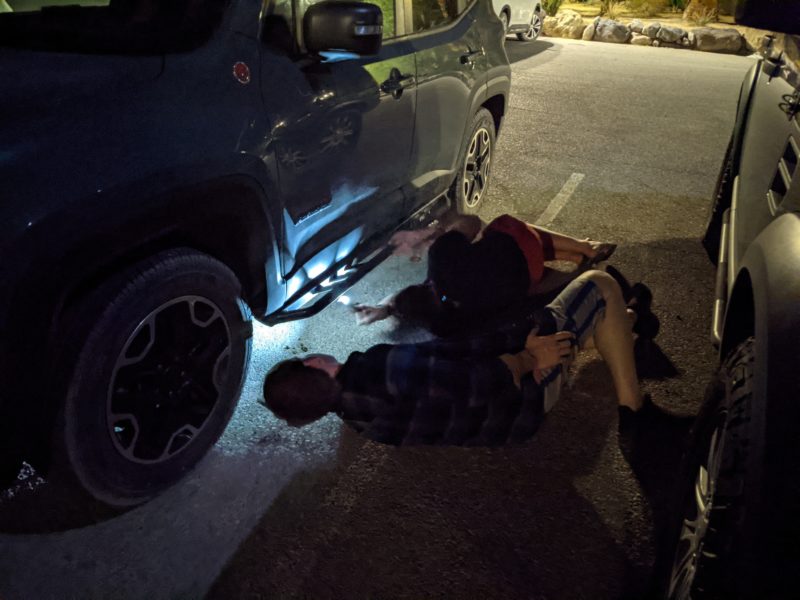
Though George seems to appreciate the expansive parking area in which to examine the rust on his rock-rails. It’s time to go to bed, sir.
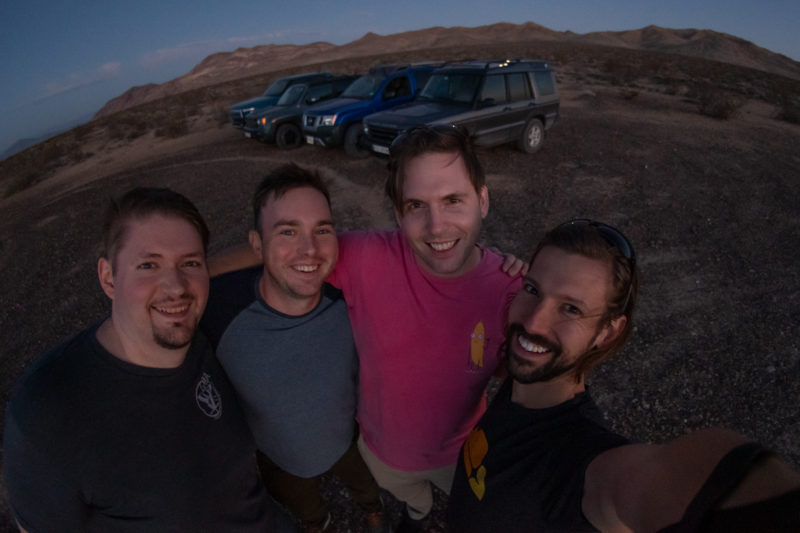
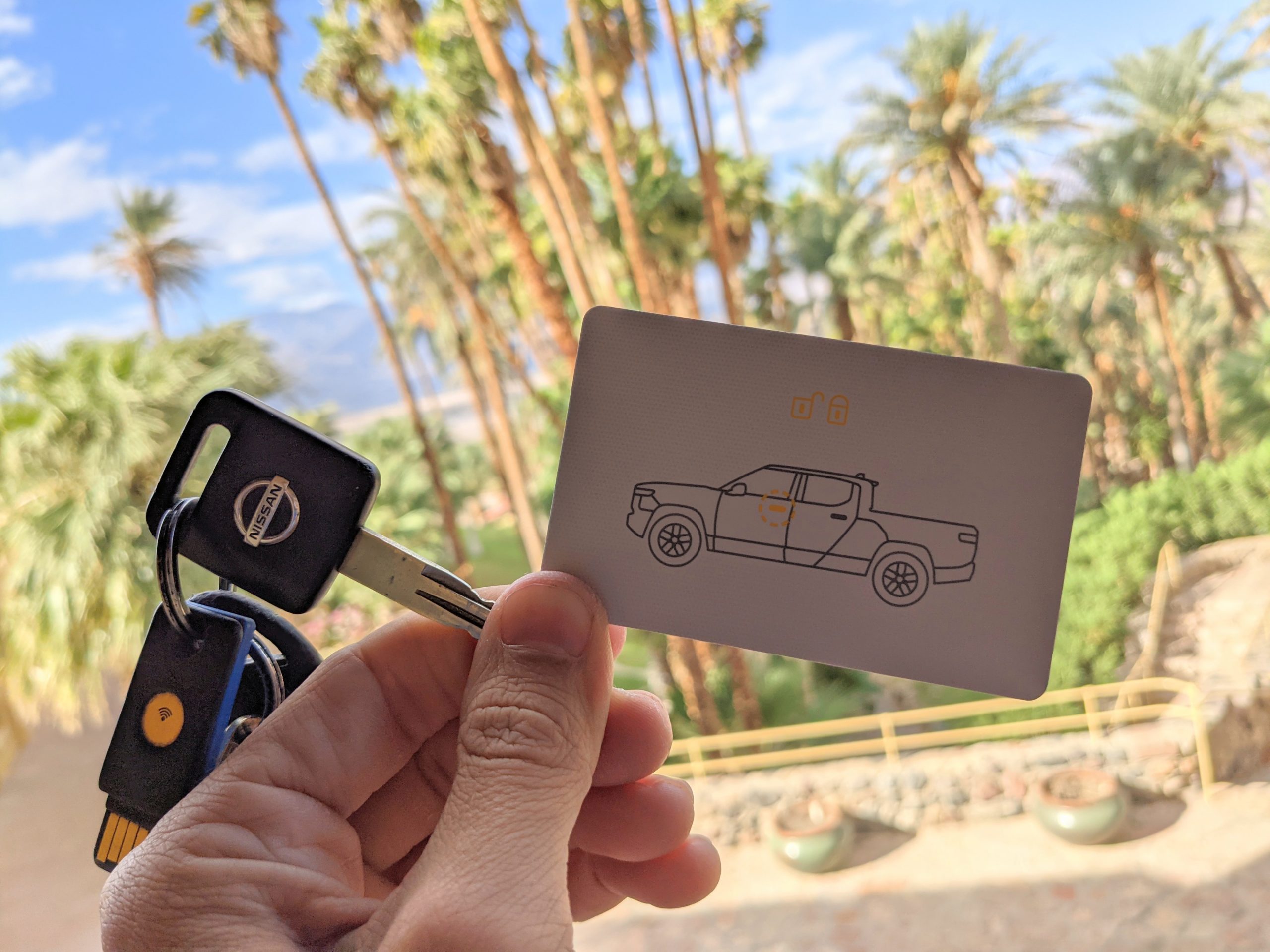
One of these things is cooler than the other. Even if, curmudgeon that I am, I still prefer my normal keys. (This is his backup, he’s got a fob for normal use.)
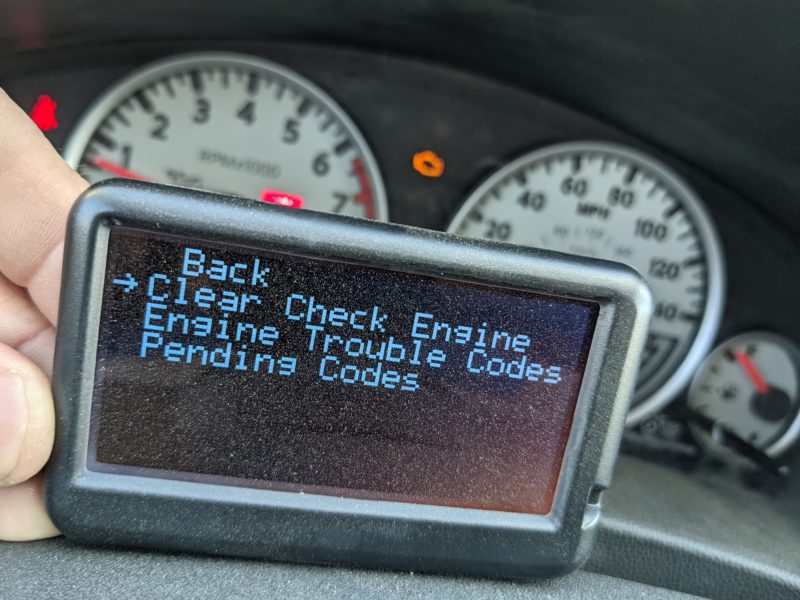
Shame a vehicle marketed for off-road use can so easily get its evap clogged by off-road dust…
Evan and I were up earlier than we wish we were on vacation, but for whatever reason, we couldn’t sleep in. So we wandered the grounds until it was time to hit the trails. The Oasis is lovely, but the water features and the golf course do strain the messaging about being in a desert with a water shortage.
Two big overland drives today. We left the park to Beatty, NV via Chloride City and then returned via Titus Canyon Road — the trail we did back in 2017.
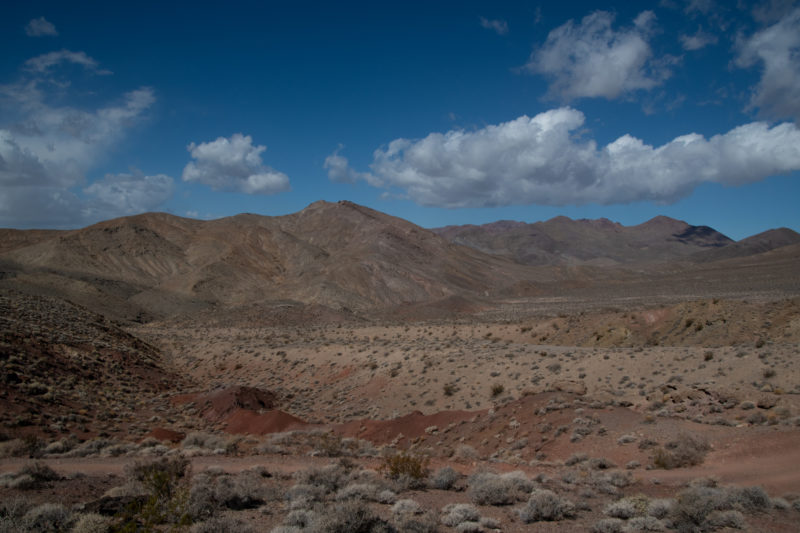
The history of Chloride City seems to depend on which website is retelling it. According to the Parks service, Chloride City became a town in 1905 during a strike at the nearby Bullfrog mine. “There are numerous adits and dumps in the area and the grave of one James McKay, of whom nothing is known. In addition, there are remains of 3 stamp mills.” It was abandoned a year or so later. Other sources point out that it was one of the earliest Death Valley mines, but perhaps not very productive. They had a helluva view though.
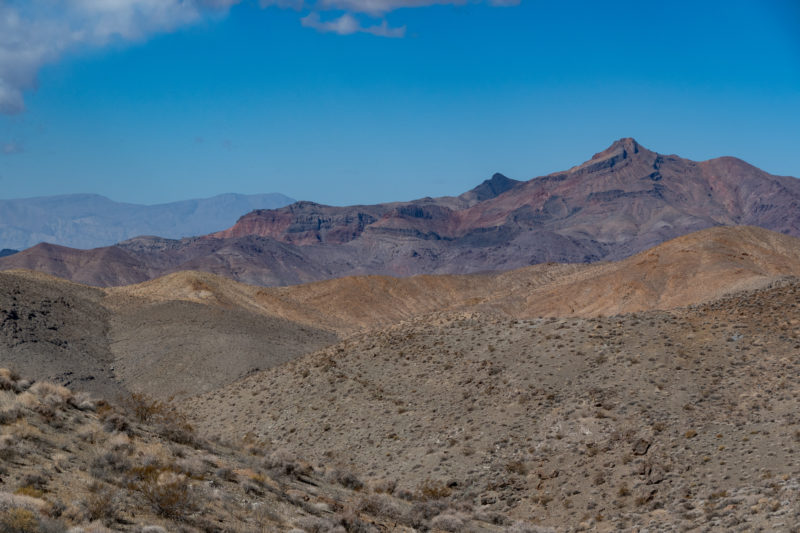
The site was 10-15 miles off the highway to Beatty up on a mountain, which got rocky pretty quickly. That was great fun.
A lot of the trail was fairly easy going, but it got surprisingly difficult in places. Definitely enough tricky stuff to keep it exciting. There was one big “walk it and be spotters for each other” section. I thought I had great dashcam footage of my trek up in the Xterra, but something seems to have malfunctioned. I’m actually quite sad about it, that was a neat little moment.
Just know that I almost drove off a mountain and used some foul language, but I righted myself with enough poise that I could tell I’ve gotten better at doing this over the years — thought not good enough to have not almost driven off the mountain in the first place. We each commented that if we’d tried this road in 2017 as originally planned, we would have been in huge trouble.
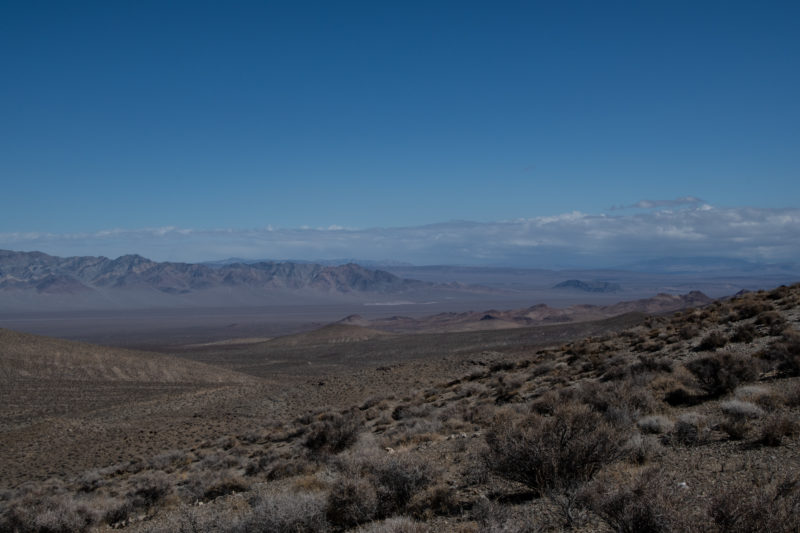
I would like to commend the Rivian for its composure. Andrew made quick, seemingly effortless work of many of the obstacles. One useful tool I learned about is the set of cameras around the wheel wells and in the front bumper, so it’s easier to see. There are also some fancy buttons that deploy mystical off-road magic powers. Still, starting with Chloride Cliffs Road instead of Titus Canyon meant we were doing the harder drive first.
When we made it to the to what remains of the town, Evan and I definitely did not immediately enter the mine through the hole in the wire mesh that was intended to keep people like us out. To our credit, it had already been breached by someone else. And thankfully that someone else wasn’t waiting inside to kill us.
Fifty feet-ish down the passage, there was an opening with a gated path upward to the surface and a slippery looking descent into darkness which was surely guarded by ghosts. We took photos but did not trespass further.
Once safety back outside, we packed back up and headed down to Beatty for another backtrack tour: That damn Denny’s. We topped up on fuel because gas at Furnace Creek is pushing $7. Andrew was also able to charge briefly, and I got to watch what has apparently been a theme: a steady stream of oglers gawking at the R1T and asking questions during charging stops. (I say, judgmentally, as I wrote a blog post gushing about this car…)
After lunch, the main event: Titus Canyon Road. It was one of the first epic trails on the Southwest Offroadtrip in 2017. I’ve been back a couple times since, but George has wanted to do this in the Renegade since he got it. And it seems right for Evan to return here in the Disco as well.
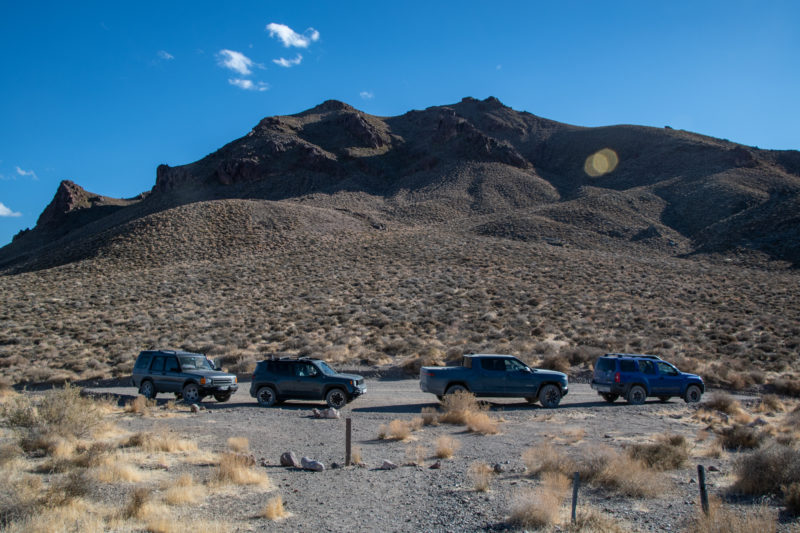
So after I diagnosed my error code as a clogged evap canister relief valve and cleared it, we set off to Leadfield along Titus Canyon Road. The story of Leadfield is much better documented than Chloride City. And somehow, it escaped being recounted the first time.
Courtney Chauncey Julian (“C. C. Julian”) was, as George put it, “a shyster.” He founded Leadfield as a lead mine, though there were also rumors of gold. “The product of extensive and fraudulent advertising by the Western Lead mine company and C. C. Julian, the town boomed in 1925.”
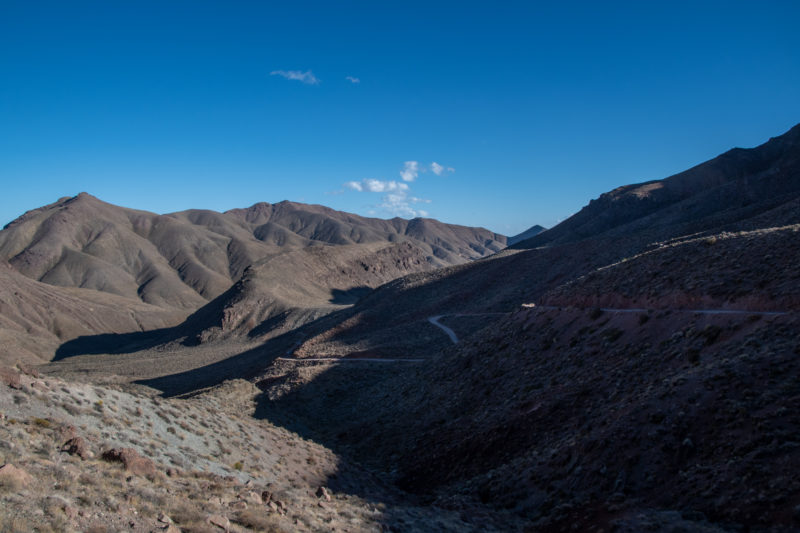
This town was the brain child of C. C. Julian, who could have sold ice to an Eskimo. He wandered into Titus Canyon with money on his mind. He blasted some tunnels and liberally salted them with lead ore he had brought from Tonopah. Then he sat down and drew up some enticing maps of the area. He moved the usually dry and never deep Amargosa River miles from its normal bed.
National Parks Service, quoting Betty J. Tucker, writing in a 1971 issue of Desert Magazine. (Link)
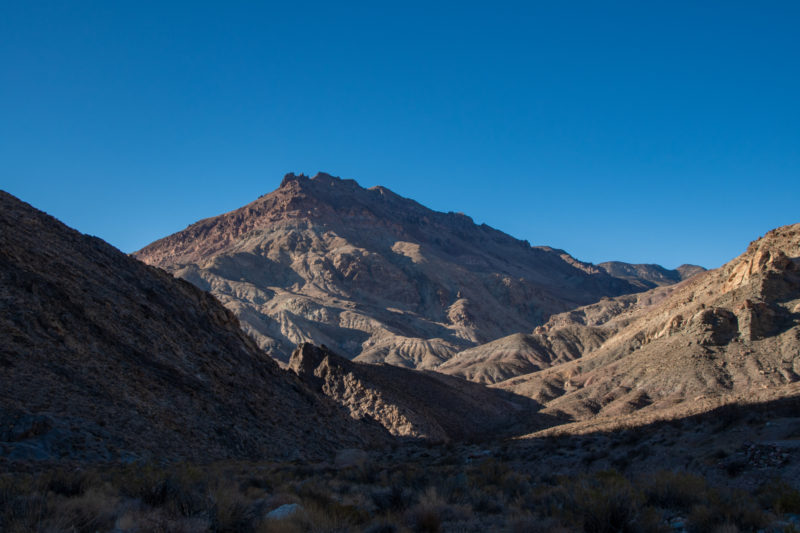
Julian’s advertising went so far as to include illustrations of steamships on a river through this desert, which obviously never existed. This glorious road he constructed follows a wash, but that’s it. Regardless, at its height, over 300 people worked the mine and a post office was constructed in August of 1926.
Two events took place which spelled the end of Leadfield. The main tunnel of the Western Lead Mine finally penetrated the ledge which the company had been tunneling towards, where its geologists had felt the best lead deposits would be. Instead of finding high-grade lead ore, the company found almost nothing. The ore assayed only 2 percent lead, far too small a percentage to mine profitably, considering the high freight costs.
The other being that the California Corporation Commission halted further sales of stock in this un-permitted company, leaving Julian without room to raise further capital. The mine and the post office closed in February of 1927. The town died shortly thereafter, leaving little more than a fantastic story and a lovely picnic spot of abandoned buildings along Titus Canyon Road.
For his part, C. C. Julian went on to found a similarly fraudulent oil business in Oklahoma. Somewhere along the way, he picked a bar fight with movie star Charlie Chaplain who roundly kicked the shit out of him. Not long after, he moved to China to escape prosecution for his financial crimes, where he spent the rest of his life.
But back to us.
Though it is a dramatic drive, it’s approachable so we encouraged Andrew to take the lead into the canyon. I swear, Captain “I’ve Got a Button for That” put a quarter in his Rivan and they took off — keeping up with them was a surprising amount of work and a lot of sloshing around on loose dust and gravel. I had so much fun.
Titus Canyon ends in dramatic fashion, ramping up the excitement until suddenly this road through a slot canyon spits you out into the unlimited expanse of Death Valley, wishing you could immediately give it another go. Instead, it was time to watch twilight fade and head back to Furnace Creek.
We had dinner at the buffet at The Ranch, just down the road from our hotel. Andrew drove us there and we fiddled with all the interior toys. Until he demonstrated his Millennium Falcon-esque acceleration capabilities… He came to a stop in the middle of the park highway and then floored it. We jumped to hyperspace. Which was good because somehow we’d gotten hungry again.
This was our only full day in Death Valley, but we’ve got time tomorrow for a little more fun before we head on toward Mesquite.
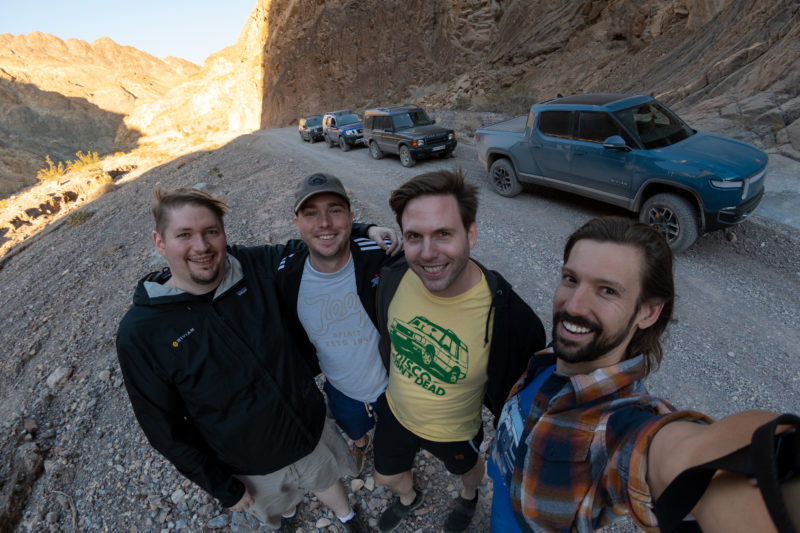
Today was a bit of a relocation cruise. After packing out of the resort, we headed down to the Badwater Basin salt flats, the lowest point in North America at 282 feet below sea level.
Then we said goodbye — or at least, “until next time,” — to Death Valley and made our way up to a fast charger at Amargosa Valley. I’ll admit I was sad to leave the park on a paved road. Or at all. We got gas and electrons over a hood-lunch and map planning.
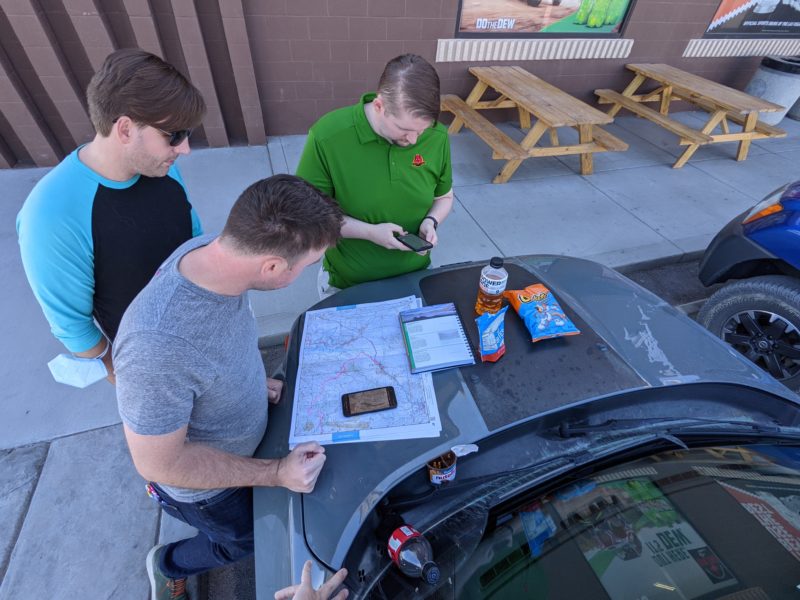
The plan was to head to Las Vegas, top-off gas and batteries north of town, then hit the Nellis Dunes in Las Vegas Dunes Recreation Lands — what looked like an off-highway-vehicle park in the sand dunes northwest of town. Once we arrived, we realized this was probably only used for ATVs and that regular vehicles may be either against the rules. Or at least sufficiently against local customs to create a scene. So we moved on, but not before Andrew did some donuts in the Rivian. We’ve been asked to keep those sights to ourselves for the time being, but I offer this instead:
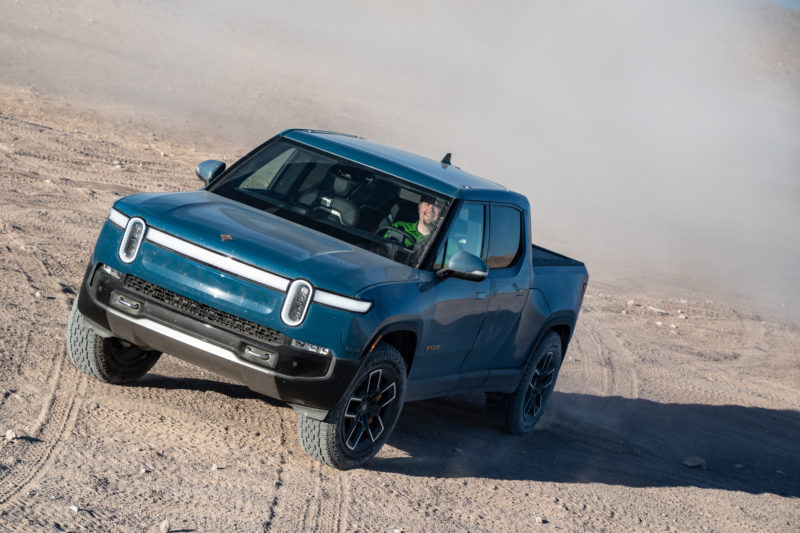
That is a happy driver. In a dust cloud of his own making. He and that vehicle have done well by each other these past few days. I’m glad he came along.
We didn’t have much time left before the sun went down, so we decided to swap Valley of Fire State Park for a road over Mormon Mesa instead. The mesa sits at the confluence of the Muddy River and Virgin River at a height of almost 1900 feet and is a lot more fun than taking I-15 through the Virgin River Gorge, which I did last year. The road connects two large electrical substations and snakes between power poles over the mesa and through several washes.
The start was a rousing game of Mariokart beneath the power poles. We weaved through sandy banks trying to kick traction out of control while heckling each other. It was great times. And then George made a discovery:
Yes, that was the moon.
The top of the mesa was a cobblestone catastrophone, bouncing us around on unforgiving surface. I was starting to worry the rest of the road would be like that until we had a dramatic downhill back into the wash . The rest of the road was fun, though I wish we’d been able to see it in daylight.
The road met up with the substation on the far end and dumped us out onto Riverside Drive in Bunkerville, a few miles down from Mesquite and our lovely CasaBlanca Resort and Casino.
This was Andrew’s final day with us. In the morning, he’ll head back west to Palo Alto. Upon his return, he’s expecting the team at Rivian to do some inspections while he has a few more days of well-earned vacation. George, Evan, and I will be heading back down into Grand Canyon-Parashant National Monument and Bar 10 Ranch for some new road and some favorites.
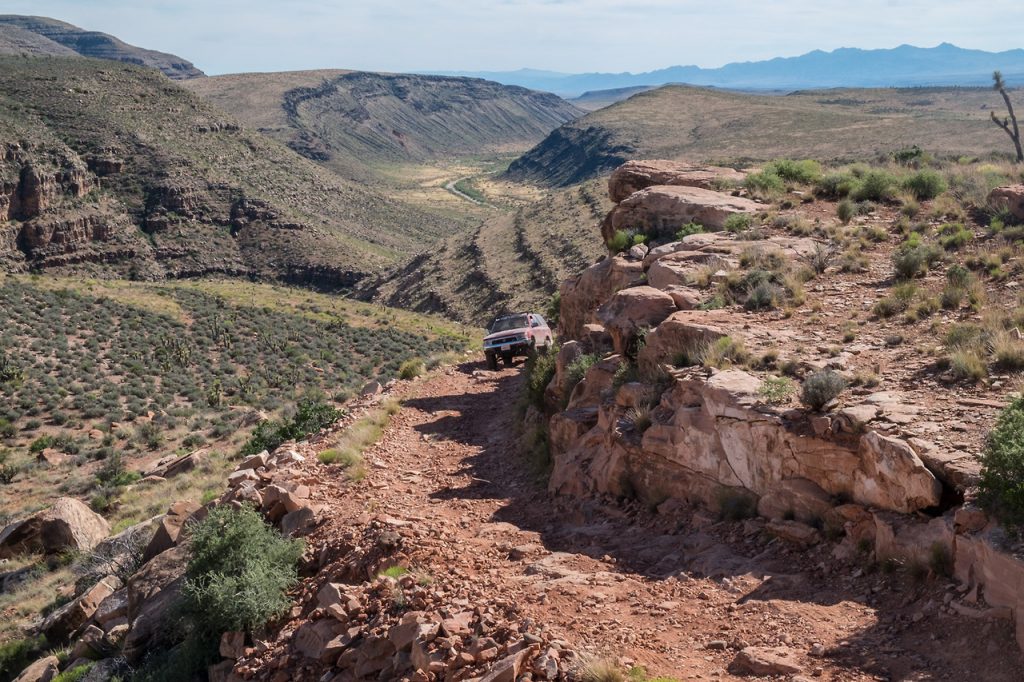
This might also be the last internet access I have for a few days. I’ll post a couple check-ins along the way so you know we didn’t fall in the big ditch though.
It was good fun to have Andrew along, and it was fascinating to bring an EV along on this trip. This is probably the first time an electric vehicle has done at least some of this.
Evan maintains that the EV is “the LaserDisc of Cars” — a short-lived video format of the late 90s with VHS-ish-quality stored on an optical disk the size of a vinyl EP. But it took LaserDiscs to get us off magnetic-tape cassettes and into to DVDs and Blu-Ray.
Evan thinks that the ethical, environmental, and logistical issues with batteries will send us looking elsewhere for the future of cars — that the EV is a step on the path of “we have to try something new.” But when I look at the progress of batteries over even the last 5 years, I think, “well, if we get a car running well on electrons, then we can swap out the generation and storage mechanisms as we learn more.” Could go either way, I suppose, but this is definitely a huge shift. And this shake-down of the R1T went pretty well overall.
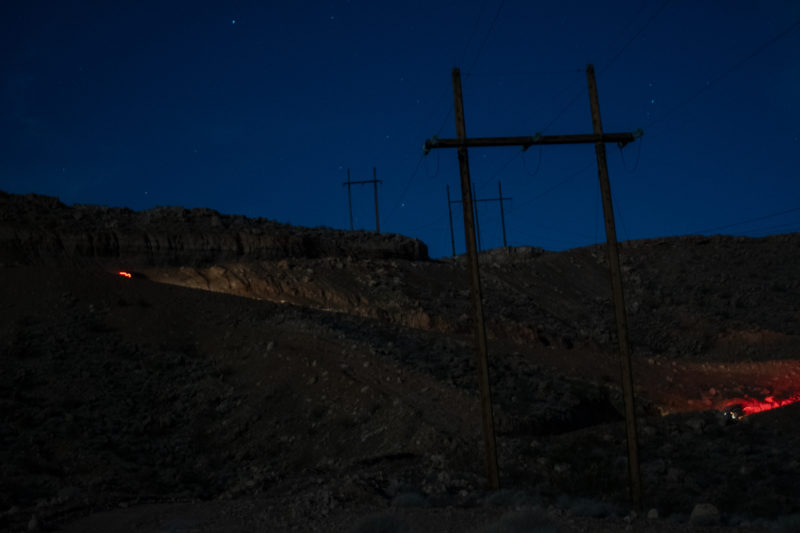
To Bar10 okay. Nutter Twists Rd obstacle harder this time w washout; like stairs. Went well! Later, Jeep drove off ledge into wash; was rescued
Taylor Smith sent this message from: Lat 36.274087 Lon -113.232629
Toroweap Ovrlk, Nampaweap Petroglfs. Stunning views; dusty drive. Evening w gentlemen on epic reunion trip finding a sundial they built in 80s.
Taylor Smith sent this message from: Lat 36.274903 Lon -113.233359